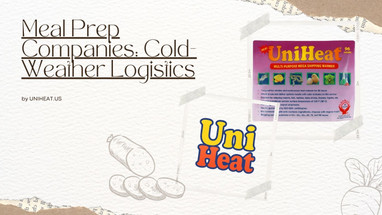Posted by UniHeat Shipping Warmer Experts on 24th Nov 2025
Meal Prep Companies: Cold-Weather Logistics
When temperatures drop, meal-prep shipments face hidden risks beyond spoilage—and standard cooling alone may not be enough. Whether you’re shipping fresh prepped meals, gourmet produce, or chef-prepared kits, managing cold, variable transit conditions is essential. Incorporating UniHeat shipping warmers—originally developed for live animals, insects, and plants—can ensure your meals stay within safe internal temperature zones during the colder months.
1) Why Cold Weather Threatens Meal Prep Shipments
Most meal-prep companies focus on keeping products cold—but in cold weather, you must also prevent them from freezing or experiencing freeze–thaw cycles. Frozen components can affect texture, taste, safety, and packaging integrity.
- Proteins & sauces: Cold exposure can cause separation, condensation or freezer-burn when thawed too quickly.
- Packaging: Gel packs or standard insulation may allow internal temps to drop too low during layovers or transit delays.
- Fresh produce & meal kits: Sensitive to both freezing and rapid reheating—consumers notice texture and flavor changes.
Because carriers and hubs are often unheated overnight, shipments marked “chilled” at origin can very quickly become at risk. Adding a controlled warmth buffer helps mitigate that risk.
2) Using UniHeat Warmers to Buffer Cold Transit Conditions
UniHeat warmers provide moderate, oxygen-activated heat that doesn’t overheat your package but keeps it above critical cold thresholds. While they were originally designed for live animals, their steady warmth and safety profile make them ideal as a “safety net” for cold-weather food shipments. :contentReference[oaicite:0]{index=0}
- 40-Hour UniHeat Pack — Good for 1-day flights or chilled ground shipments in mild winter conditions.
- 72-Hour UniHeat Pack — Ideal for 2-3 day shipments, multi-stop routes, or cold-weather zones.
- 96-Hour UniHeat Mega Warmer — Recommended when shipment may sit overnight, cross through cold hubs, or encounter delays.
3) Packaging Strategy for Meal-Prep Companies in Cold Weather
Layer your packaging system to deal with both cold and heat threats:
- Insulated outer box: Use foam-lined cartons or thermal liners to prevent external chill from penetrating.
- Active cooling layer: Gel packs or reusable cold packs keep the product in the safe “chilled” zone (typically 35-45°F).
- Heat buffer layer: Place a UniHeat warmer above or beside the cooling layer—not touching the product—to raise internal box temps if external temps drop below target.
- Vent/air flow: Ensure slight ventilation for oxygen flow to the UniHeat pack (2–4 small holes in the outer box) while maintaining insulation integrity.
By adding the warmth buffer, you protect against “over-chilling” and freeze damage while maintaining the cold chain. It's a prudent backup when ambient temps dip unexpectedly.
4) Route & Weather Risks Unique to Food Delivery Businesses
Meal-prep companies must account for many transit variables beyond mere courier days:
- Weekend delays: A Friday shipment may sit in a cold warehouse over Saturday.
- Inter-modal transfer points: Meals often transfer through hubs that aren’t climate-controlled.
- Last-mile outdoor exposure: Delivery by truck or courier to doorstep in below-freezing conditions.
- Temperature differential risks: Items may go from chilled (<45°F) to warm (>80°F) environments quickly on arrival, affecting quality.
Using UniHeat warmers means you have a built-in buffer against cold or delay—reducing risk of frozen items, packaging failure, or compromised product quality.
5) Checklist for Winter-Ready Meal Shipments
- Pre-activate the UniHeat pack 20–30 minutes before packing.
- Use one pack per cubic foot of box volume; upgrade if insulation is heavy or the route is long.
- Place gel/cold packs below the food product, warmer on top or side.
- Ensure two small vent holes in the outer box for oxygen to the warmer.
- Label box: “Chilled Product – Protect From Freezing.”
- Test shipment internally with a temperature logger before peak winter season.
- Train staff: Under-packing insulation or skipping warmers are common cold-exposure mistakes.
Frequently Asked Questions
Can warmers impact cold-chain food safety?
No—when used properly. UniHeat warmers maintain moderate warmth, designed not to raise product above safe chilled ranges. They act as a buffer, not a heat source. :contentReference[oaicite:1]{index=1}
Are UniHeat warmers food-safe and approved for edible shipments?
Yes. While originally marketed for live animals, insects, and plants, UniHeat warmers are non-toxic and safe for sealed food shipments. With proper insulation and separation from the product, they’re suitable for meal-prep logistics. :contentReference[oaicite:2]{index=2}
How many warmers should a meal-kit company use per box?
A good rule of thumb: one UniHeat pack per cubic foot of insulated space, and increase if box is oversized or route is multi-day in winter. Always test with internal temperature monitoring.
Do I still need gel packs if I use a warmer?
Yes. Gel or cold packs maintain chilled temps. The UniHeat warmer doesn’t replace cooling—it prevents over-chilling and freeze damage when ambient drops unexpectedly.
Summary: Meal-prep companies face a double challenge in cold weather: keeping products chilled without freezing. A layered shipping strategy—gel cold packs + quality insulation + a UniHeat warmer as a thermal buffer—provides resilience and maintains product quality. Explore UniHeat’s 40hr, 72hr, and 96hr options for your shipments at UniHeat.us.

